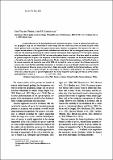Por favor, use este identificador para citar o enlazar a este item:
http://hdl.handle.net/10261/133551COMPARTIR / EXPORTAR:
 SHARE SHARE
 CORE
BASE CORE
BASE
|
|
| Visualizar otros formatos: MARC | Dublin Core | RDF | ORE | MODS | METS | DIDL | DATACITE | |

| Título: | Occurrence data may provide unreliable thermal preferences and breadth of species |
Autor: | Villén Pérez, Sara CSIC ORCID; Carrascal, Luis M. | Palabras clave: | Abundance-temperature response curve Birds Species occurrence Thermal breadth |
Fecha de publicación: | 1-dic-2015 | Editor: | Oxford University Press | Citación: | Current Zoology 61(6): 972-982 (2015) | Resumen: | Accurate information on the thermal preference and specialization of species is needed to understand and predict species geographical range size and vulnerability to climate change. Here we estimate the position and breadth of species within thermal gradients based on the shape of the response curve of species abundance to temperature. The objective of the study is to compare the measurements of this approach based on abundance data with those of the classical approach using species’ occurrence data. The relationship between species’ relative abundance and minimum winter temperature of 106 bird species wintering in the Iberian Peninsula is modeled at 100 Km2 resolution with quadratic logistic regressions. From these models we calculated the preferred temperature of species as the temperature at which the abundance is maximized, and the thermal breadth of species as the relative area under the temperature-abundance curve. We also estimated the thermal preferences and breadth of species as the average temperature and temperature range of the UTM cells in which the species are present. The abundance-temperature response curves reveal that birds prefer higher temperatures to overwinter, and are more thermally selective, than is measured by the classical approach. Moreover, response curves detect a higher inter-specific variability in both thermal preferences and thermal breadth of species. As occurrence data gives the same weight to cells with one or many individuals, the average temperature of the cells in which the species is present roughly reflects the average temperature in the region of study and not the environmental preferences of species. | Versión del editor: | http://dx.doi.org/10.1093/czoolo/61.6.972 | URI: | http://hdl.handle.net/10261/133551 | DOI: | 10.1093/czoolo/61.6.972 | ISSN: | 1674-5507 | E-ISSN: | 2396-9814 |
| Aparece en las colecciones: | (MNCN) Artículos |
Ficheros en este ítem:
| Fichero | Descripción | Tamaño | Formato | |
|---|---|---|---|---|
| Current Zoology 61(6) 972-982 (2015).pdf | 1,67 MB | Adobe PDF |  Visualizar/Abrir |
CORE Recommender
PubMed Central
Citations
1
checked on 10-abr-2024
SCOPUSTM
Citations
3
checked on 17-abr-2024
WEB OF SCIENCETM
Citations
3
checked on 29-feb-2024
Page view(s)
232
checked on 23-abr-2024
Download(s)
216
checked on 23-abr-2024

